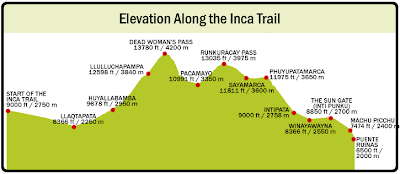June 18, 2012
Years ago in Utah I mentioned to several people at work that a company trip to Machu Picchu would be a great thing to do. After moving to Peru I found out that you could actually hike the original Inka trail for several days before arriving at Machu Picchu. Our good friend from the Lima office, Vladimir Gonzales, helped set things up. Thus was the begining of "The FLSmidth Hike to Machu Picchu and the IntiRaymi Festival of the Sun".
It was an unforgettable experience for the Adams, Gamble, Nilson, McDonald and Nielsen families. Thanks again to Vladimir Gonzalez, a big man with an even bigger heart!

The trail seemed daunting. Up and down during 3 1/2 days with
over 17,648 feet in elevation change during nearly 40 km of hiking.
My great wife agreed to go. It was an ambitious hike for her first time out. Lots of unknowns like; how cold will the nights be? will they give us enough food? Where are the bathrooms?
We saw Inca sites that were only accessible by doing this 4 day hike.
Runkurukay. Fortress or Storehouse?
The views got better and better the longer we walked.
Our group of porters, cooks and guide (arms out) at the beginning of our 2nd day.
Once we left this camp there was no turning back.
Our porters ran the trail fully loaded while us city folk slowly made our way.
Looking up at dead Woman's Pass at 13,780 feet above sea level.
A mere 5 hour morning jaunt.
Almost to the top.
They told us that going up was actually the easy part.
My lungs would beg to differ.
Proof that we made it to the pass at 4,215 meters above sea level.
All in pretty good shape.
The difficulty going down was the high and narrow steps.
Sometimes more than 15 inches high and only 8 inches wide.
Sidestepping for 4 hours was the easiest on the knees.
This was typical of our campsites each night. Dining tents
along the front and romantic "tents for two" all in a row.
The dinners were always GREAT and more than we could eat.
The 2nd day started UP again.
Almost at the top of the world.
After we left camp each the morning the porters cleaned up, packed up
and then passed us up on the trail. The same thing happened after lunch.
The dining tents were ready with hot food on the tables (with table clothes)
when we drug into camp at lunch and dinner.
The porters clapped for us as we stumbled into camp each time...
no matter how late we were.
The bundles they carried must have weighed over 50 pounds.
Notice the grass in their sandals to soften the impact
going down the thousands of stone steps.
Up again..to another Inca site. Sayaqmarka. 3625 meters above sea level.
"Floating stairs" were common for quicker access between terraces.
Down again.
The Incas did not cut trails into the side of the mountain like in the USA.
The mountains are so steep that a retaining wall was built, sometimes from
30 feet below the finished trail level, and then the area filled in and paved with stones.
There were 3 natural tunnels along the trail.
30 feet of steps cut into rock slab.
Steps...and more steps.
No...this was not the end of the trail!
Remote farm lands.
We could see the river in the canyon below but none of these sites were visible from below. Though never publicized, the sites were never "lost". The locals knew about these sites and used them off and on for farming during the 500 years after the Spanish wiped out the Inka civilization.
I think the Inka trail was "one way" because, in the direction we were traveling,
the really big steps were always on the down side.
Winaywayna was our prize at the end of the 3rd day.
Terraces for farming, a nice little village and a religous center up at the top.
You can appreciate how steep the mountains are.
It is amazing that the Inkas had the foresight and determination
to clear the land and make it usable for farming.
As rough ar the stones were, all the buiulding lines were perfectly straight.
How did the Inkas cut these stones so precisely? 10 angles in one stone fitting perfectly with 8 others. Their tools were limited...no steel.
Our last day of hiking started at 3:30am.
It didn't really matter since no one could sleep very well
at the altitudes we camped at.
We arrived at the Sun Gate and waited...
for the sun to hit Machu Picchu.
Only another 45 minutes until the end of our trek.
The "group", reunited in Machu Picchu.
Vladimr Gonzales, Russ and Jan Bartsch, Tery and Mark Nielsen, Leicha and Ezra Nilson, Julie and Derrall Adams, Don and Mary Gamble, Jill, Shannon, Meghan, Caitlan and Craig McDonald.

































































